The Wolf on Crimea’s Doorstep?
What digital breadcrumbs tell us about the recent Russian military mobilization in Crimea
The Wolf on Crimea’s Doorstep?
Share this story

What digital breadcrumbs tell us about the recent Russian military mobilization in Crimea
Over two dozen videos were uploaded between August 5 and 18 showing massive redeployment of Russian military equipment through Crimea, sometimes with armored personnel carriers and missile systems ferried through Kerch from the Rostov Oblast and Krasnodar Krai in southwest Russia. In the heights of confusion around the claims of terrorism in Crimea and conflicting narratives, many claimed that the Russian movements were a harbinger of a renewed Russian offensive, if not outright invasion. These predictions were unfulfilled, but speculation continues regarding the Kavkaz-2016 military drills and ongoing deployments in Crimea and near the Ukrainian border.
The above map provides a geolocation of many of the videos and photographs of Russian military equipment movements shared online over a two-week period in August. Digital sleuths have geolocated almost every photograph and video that has surfaced, most of which were in Kerch (where a ferry transports thousands of people across the Kerch Strait into Crimea every day) or on major rail or roadways between military bases in southern Crimea.
One video shows a series of BTRs (armored personnel carriers) moving through the streets of Kerch, with a distinct white building in the background.
Catherine Fitzgerald from The Interpreter correctly geolocated the video to Kirov Street in central Kerch. A comparison of the scene in the video to the street-level imagery on Yandex Maps shows the common features, including the Kerch Hotel, the distinct building in the background.
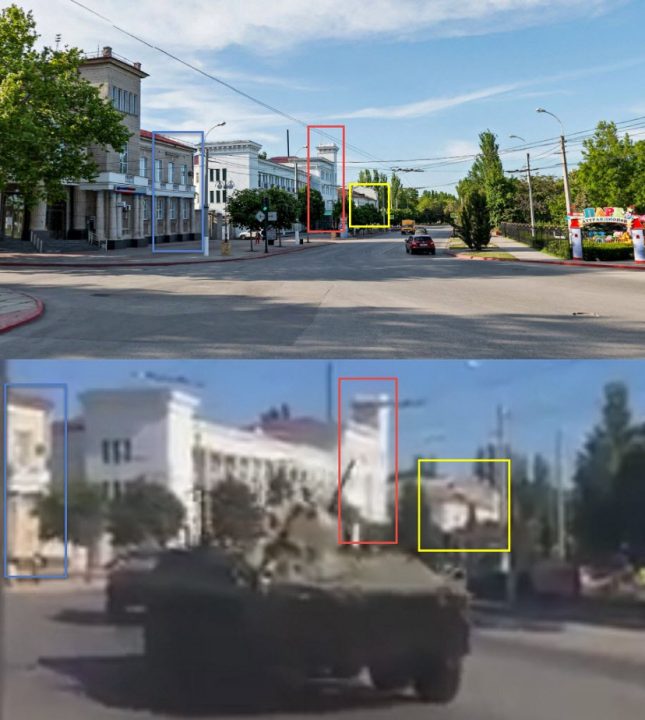
There were numerous witness accounts, photographs, and videos of other convoys of military equipment through Kerch from in early-mid August. Some of these sightings include a different video of BTRs traveling through city streets, selfies taken by a local resident with a line of BTRs in the background, and a photograph of military trucks loaded onto the railway at the Kerch train station.
Another geolocation shows where a series of nine (likely more, as the video is only 15 seconds long) BTRs are headed when traveling through Kerch. @GalendecZP, a Twitter user who has been vigilant in gathering videos of Russian military movements, found a video on Instagram showing the movements and said that it was filmed in the “center of Kerch” on August 9. However, the exact location the video was filmed in Kerch is unclear without further geolocation. Kirill Mikhailov of the Conflict Intelligence Team helped us pinpoint the location of this video, showing that the BTRs are heading north along vulitsya Sverdlovska, likely towards the ferry. Using Yandex Panorama, we can find the exact spot of the video, and recreate the perspective of the camera.
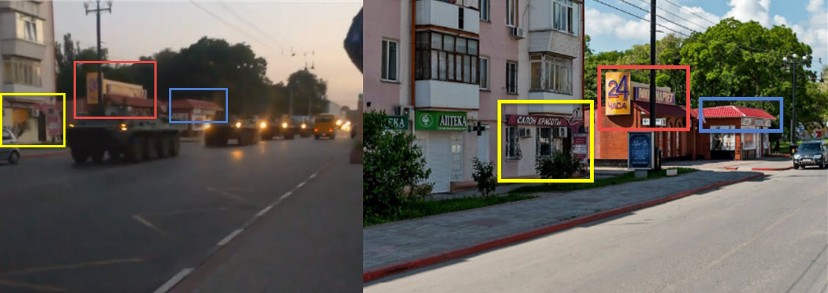
The type of military equipment that received the most attention while being transported towards and through Crimea was the Bastion-P (NATO reporting name SS-C-5 Stooge) mobile coastal defense missile system. Various components of this missile system were filmed traveling near Simferopol, Kerch, and Port Kavkaz.
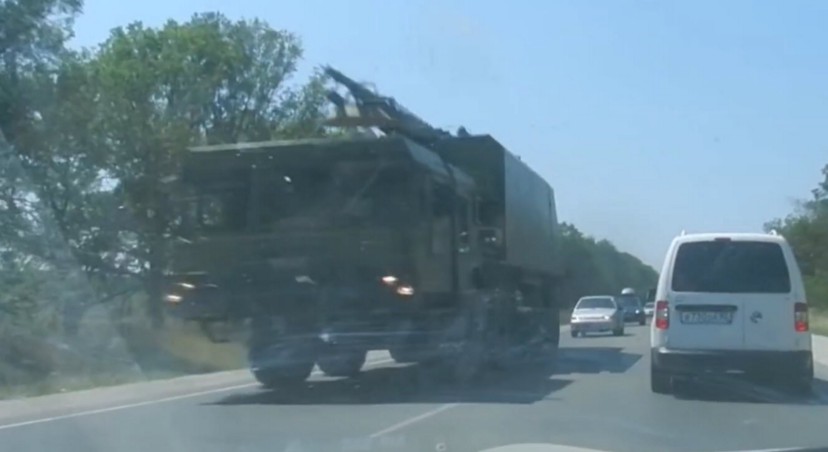
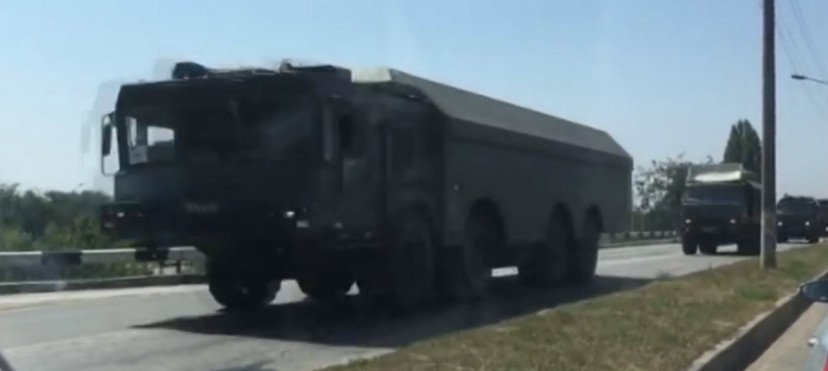
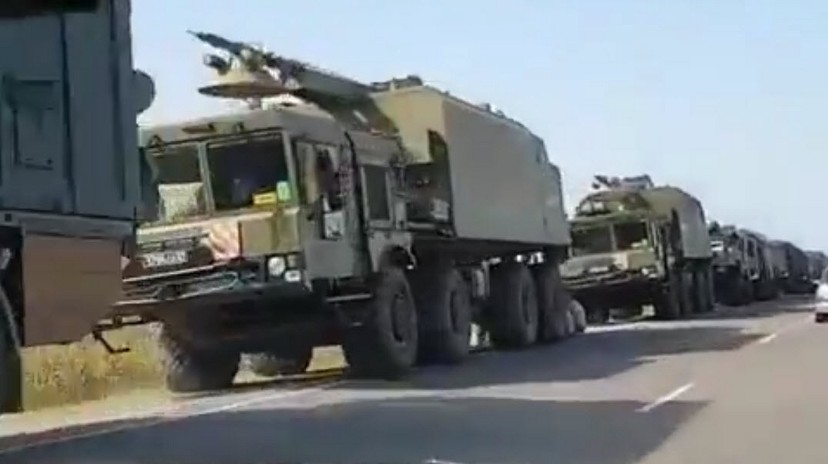

In reaction to the military movements in and around Crimea from the last few weeks, many claimed that Russia was prepping a possible invasion of mainland Ukraine through Crimea. Lending credibility to this theory were some dramatic measures taken by Russia during the ongoing Kavkaz-2016 military exercises involving the Southern Military District, which includes Crimea, the Rostov Oblast, Krasnodar Krai, and other regions that have seen a dramatic uptick of military movements. On August 29, the Russian Ministry of Defense announced that its fighter jets on the Ukrainian border are on a two-minute readiness alert, and the state-run Rossiyskaya Gazeta reports that Russian Airborne Forces (paratroopers) were deployed to the Opuk training ground in eastern Crimea. In March 2014, before Russia sent thousands of its tanks, missile systems, and active servicemen into Ukraine, President Obama and U.S. officials warned of a massive Russian military presence along the border, coinciding with military exercises. Months later, many of these troops invaded Ukraine, sent a Buk-M1 TELAR numbered 332 into Ukraine, helped win the Battle of Ilovaysk in August, and later sent a second surge in February 2015 to secure the railway hub of Debaltseve for separatist forces, all documented in the 2015 Atlantic Council report “Hiding in Plain Sight.”
The open source information does not support the conclusion that a repeat of 2014 is happening in Crimea in August 2016. Along with Crimea, we have seen significant movements and deployments of Russian equipment in the Krasnodar Krai and Rostov Oblast; however, in the case of an impending invasion from Crimea, one would expect an amassing of equipment at Russian military positions in northern Crimea, such as Dzhankoi and Armyansk. Instead, we see movements both into Crimea via the Kerch ferry, and out of Crimea via the same route, along with movement of equipment between major road and railways connecting military bases in southern Crimea, such as in Simferopol and Sevastopol. There has been witness accounts of military activity near the aforementioned northern Crimean military bases near Dzhankoi and Armyansk, but there is scant evidence indicating that there have been large-scale deployments of new equipment from Russia’s Krasnodar Krai or Rostov Oblast into these areas.
Michael Kofman from the Wilson Center’s Kennan Institute provides analysis of the Crimean confusion in a column for War on the Rocks that coincides with the openly accessible digital footprints. The military deployments in Crimea are not likely an omen of an invasion, but instead a combination of the Kavkaz-2016 exercises that were already scheduled to be held in the Southern Military District, regular rotations, and a possible upsurge in activity in Syria. It should be noted that Russian troops and equipment often leave from Crimea to reach Syria. Kofman suggests that “most of the current activity is likely in response to the security alert on the peninsula, with other troop movements planned well in advance” and “in line with an intense schedule or readiness checks and troop rotations set for August and September.” As Kofman points out, a U.S. official’s statement supports his conclusion, saying that “a recent rotation of several divisions of Russian forces into Crimea to relieve an equal number, which have since departed.”
Additionally, the photographic and video sightings of Bastion-P systems that went viral on social media should not come as a shock, as Russia deployed these missile systems in Crimea in 2014 — and they were prominently displayed in the May 9, 2014 Victory Day parade in Sevastopol. Furthermore, there are videos from Russian media of the Bastion-P system performing exercises in Crimea in 2014. Russia may be sending more Bastion-P systems that will remain after the Kavkaz-2016 exercises, but their deployment in Crimea was well-known over two years ago.
Port Qavqaz today (Kerch ferry) https://t.co/TM5IzjfH9z pic.twitter.com/UulmN7ktE4 via @GirkinGirkin
— Liveuamap (@Liveuamap) August 26, 2016
We continue to see military movements in Crimea, especially between Kerch and Port Kavkaz. However, rather than the precursor of an invasion of Ukraine, some of these movements could be focused towards a different country that Russia is military involved with: Syria. Some have speculated that some troops arriving in Kerch may be headed towards Syria, judging by their desert camouflage and recent escalations in Aleppo. However, this hypothesis is still unconfirmed.
Керчь, 28 авг
путенские в "сирийском" pic.twitter.com/QdaIQrTcz0
— IgorGirkin (@GirkinGirkin) August 28, 2016
The United States and other Western nations have criticized the opaque nature of the Kavkaz-2016 exercises, as Russia has not allowed observers at the exercise, though Russian observers were invited to NATO’s large-scale military exercises in Poland in early 2016. A Russian invasion of Ukraine through Crimea is unlikely, despite some warnings of a “full-scale attack” in Russian and Ukrainian media. However, Ukraine still does not have control over much of its eastern border — where many Russian troops are mobilizing for the Kavkaz-2016 exercises. More worrying, many of the troops participating in the exercises have previously sent dozens, if not hundreds, of active servicemen, tanks, artillery systems, and other military equipment into Ukraine. One of these groups participating in the exercises near Ukraine is the 200th Motorized Infantry Brigade from Pechenga (Murmansk Oblast), which independent Ukrainian researcher “Askai707” proved was a significant factor in fighting in the Luhansk Oblast in the summer of 2014. While the open source evidence does not indicate that a full-scale invasion will happen, especially from Crimea, there is the possibility that additional troops, equipment, and support could yet again flow through the uncontrolled border under the guise of military exercises.
Going forward, Digital Sherlocks will continue to monitor Russia’s Kavkaz-2016 military exercise and further military movements in Crimea. Some of the most active Twitter users tracking these activities are @GirkinGirkin (@Loogunda often translates his tweets into English) and @GalandecZP. Additionally, you can search for photographs and videos uploaded by Russian servicemen by searching the #Кавказ2016 (Kavkaz2016) hashtag on Instagram and Vkontakte.
Follow the latest Minsk II Violations via the @DFRLab’s #MinskMonitor.
For more in-depth analysis from our regional experts follow the AtlanticCouncil’s Dinu Patriciu Eurasia Center. Or subscribe to UkraineAlert.


